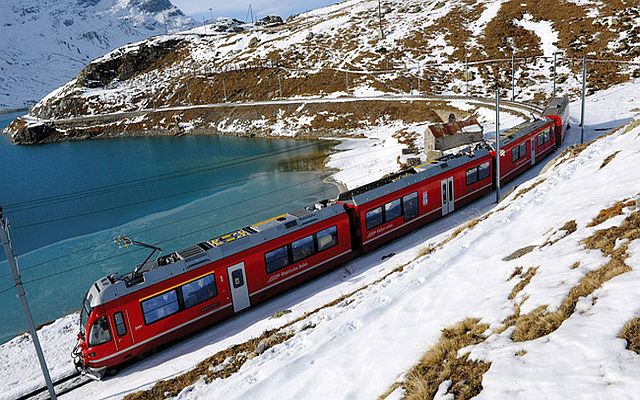 |
| The Bernina Express exits a tunnel to cross the majestic Landwasser Viaduct (wikipedia) |
Nowhere in Switzerland, or
even Europe, is there more geographical diversity than the Bernina Express.
With glaciers, impressive bridges, picturesque tunnels, lakes, mountains,
rolling landscapes, rivers and a starting or ending point in Tirano, Italy, the
Bernina Express is the stuff of traveler’s dreams.
 |
| The Bernina Express features diverse scenery (wikipedia) |
Not only does the route
incorporate some of the most spectacular sections of the famed Glacier Express,
it also glides across the crest of the world where the watershed originates
some of the great rivers of Europe.
Even National Geographic rates the Bernina Express as the second best
rail journey in Europe. The first, also
in Switzerland, is The Chocolate Train.
Bernina Express travelers
begin from either Davos, St. Moritz or Chur.
Each village offers something different, so the starting point is really
a matter of personal preference.
Chur, with its delightful old
town, is a gateway to the alpine ski resort of Arosa.
 |
| Panoramic view of Chur, one of the gateways for the Bernina Express (wikipedia) |
At just over 5,000 feet,
Davos has the distinction of being the highest city in Europe, and it is a
haven for culture lovers as well as sports enthusiasts.
Jet-setting St. Moritz, with
its series of three alpine lakes, has long been a favorite destination for the
internationally rich and famous.
 |
| One stunning vista after another (wikipedia) |
The four-hour, 38-mile rail
journey follows a winding mountainous path over 196 bridges and through 55
tunnels over the Bernina Pass which reaches its highest point at more than
7,300 feet. Two railways, the Albula
Line and the Bernina Line, combine to form the route. A unification that led UNESCO to jointly
declare them a World Heritage Site in 2008.
Completed in 1904, the Albula
Line took six years to build. The
Bernina Line followed in 1910, but the railroads operated independently until
1940 when the Rhaetian Railway took over and merged the two.
The brightly colored red
coaches feature arches of glass that provide a 360-degree panoramic view of
land, water and sky. During summer, some
trains even operate with a few open-air cars as well as the traditional
enclosed rolling stock.
 |
| The Landwasser Viaduct/Tunnel is a highlight of both the Bernina Express and the Glacier Express (wikipedia) |
The combination Landwasser
Viaduct/Tunnel is a highlight of both the Bernina and Glacier Express
excursions. From the viaduct, where five
pillars tower more than 200 feet above the Landwasser River, the 446-foot
curved track offers passengers a clear view of the train as it enters or
departs the tunnel. The 706-foot tunnel
completes the architectural masterpiece by boring through seemingly insurpassable rock before opening upon the dramatic gorge and bridge across the
river.
Shortly after the viaduct, the train reaches
Filisur before continuing through the first of several spiral tunnels. The rails sing as the cherry-colored line of
coaches moves through a lush valley en route to a change in elevation of about
1,300-feet in just over 3-miles. Spirals
eliminate the need for rack-and-pinion infrastructure and passengers are the
beneficiary. The serpentine course
twists and turns through towering woodlands past cascading waterfalls and
rushing streams while climbing toward mountains of everlasting snow.
 |
| The Bernina Express operates year round (wikipedia) |
Outside Pontresina the journey heads for the Bernina Pass Eastern Alps at nearly 7,000
feet.
In English “piz” means
“peak”, which comes from Romansch, the least used of Switzerland
Before long, the Bernina
Express discards its forested surroundings by yielding to a moonscape of stark,
intolerant terrain. Jagged, barren
outcroppings of snow-clad rock hover over three glacial lakes, each distinguished
by a different color. Here, at the
rooftop of Europe, the watershed divides the flow of rivers toward the North
Sea and the Mediterranean .
 |
| The Kreis Viaduct near Brusio is another highlight with its rare exposed spiral tunnel (wikipedia) |
Once over the Alps , the train descends into another vast carpet of
green where rural tableaux nestle between protective mountains that lead toward
Brusio and its spiral viaduct. The
uniqueness of this rarest of rail travel experiences lies in the fact that the
track is completely exposed, allowing passengers to witness the logistical
achievement of the design for themselves.
The train travels over, around and beneath its own pathway as the coiled
ribbon of steel guides the express into Italy
 |
| Passing White Lake at the watershed which leads to the Black Sea and the North Sea (wikipedia) |
Before terminating in Tirano,
rail travelers and motorists discover several places along the route where it
almost seems possible to reach out and shake hands with each other, and in a
couple of tiny villages, the train has barely enough room to pass between
buildings on either side of the road.
At Tirano, the Bernina Express links with Swiss Postal Bus service which
journeys along the Italian shores of Lake
Como before arriving back in Switzerland Swiss Rail Pass
 |
| If you can only choose one rail journey in Switzerland, pick the Bernina Express (wikipedia) |
With a little basic training on the Bernina Express, anyone can experience the
magic of the Swiss Travel System.







0 comments:
Post a Comment